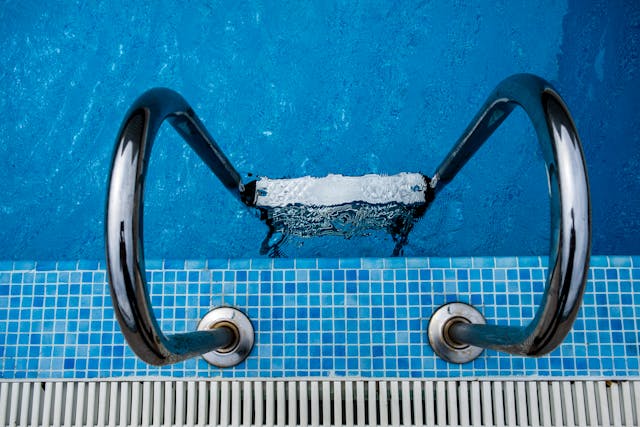Lower cyanuric acid in pool safely with effective methods like dilution, alum, RO, avoiding overuse of stabilised chlorine.
Cyanuric acid (CYA) is like that friend who’s great in small doses but becomes a burden if they overstay their welcome. In your pool, CYA protects chlorine from burning off in the sun. Without it, chlorine would vanish almost instantly on a bright day. But when levels climb too high, the same chemical turns from helper to troublemaker.
This is a challenge even luxury pool maintenance at resorts must address to ensure crystal-clear water for guests. Chlorine becomes sluggish, algae sneak in, and water that should sparkle turns cloudy. If you’ve ever felt like you’re throwing money into your pool without seeing results, chances are you’ve got a cyanuric acid problem.
This guide walks you through everything you need to know about lowering cyanuric acid in your pool, methods that work, myths to avoid, and practical steps you can take right away.
What You'll Discover:
What Is Cyanuric Acid and Why It Matters
Cyanuric acid, often called a pool stabilizer or conditioner, binds with free chlorine and shields it from sunlight. That’s helpful, but there’s a limit. The higher the CYA, the more chlorine it locks up, and the less chlorine is available to sanitize your pool.
Imagine storing all your food in locked boxes, you technically have food, but you can’t eat it when you need it. That’s how excess CYA works with chlorine. Your pool may show chlorine on a test, but much of it is unavailable for actual cleaning.
How Much CYA Is Too Much?
The “sweet spot” depends on your pool type and location, but here are general ranges:
- Residential outdoor pools: 30–50 ppm
- Pools in very sunny regions: sometimes up to 60 ppm
- Saltwater pools: 20–40 ppm
- Indoor pools: 0–20 ppm (they don’t need much, since UV protection isn’t a factor)
When CYA climbs beyond 80 ppm, chlorine becomes increasingly ineffective. Above 100 ppm, problems multiply, algae blooms, cloudy water, constant shocking with little improvement.
Signs Your Cyanuric Acid Is Too High
You don’t need a lab to tell something’s off. High CYA usually announces itself in frustrating ways:
- Chlorine feels useless. You shock the pool, but algae come back quickly.
- Water looks dull or cloudy. Even filtration and brushing don’t help.
- Chemical readings don’t add up. pH and alkalinity seem unstable.
- You’re burning through chlorine. No matter how much you add, the pool demands more.
These symptoms often appear together, creating a cycle of wasted chemicals and wasted weekends.
How to Lower Cyanuric Acid in Pool
Here are the most effective strategies to get your pool chemistry back in balance.
Method 1: Dilution (Drain and Refill)
The most direct, proven method is to physically replace water. Since CYA doesn’t evaporate, the only way to get rid of it is to remove water that contains it.
Steps:
- Test your CYA level to know how far you are from the target.
- Calculate how much water to replace. For example, if your pool is at 100 ppm and you want 50 ppm, drain and replace about half.
- Drain safely, avoiding stress on pool walls or liners.
- Refill with fresh water.
- Retest and rebalance pH, alkalinity, and chlorine.
Pros: Reliable and predictable.
Cons: Water waste, refill costs, and possible restrictions on draining.
Method 2: Reverse Osmosis (RO)
In some areas, professional services offer mobile reverse osmosis. This process filters your pool water through membranes that strip out dissolved solids, including cyanuric acid, without a full drain.
When it’s useful:
- If water conservation matters.
- If your pool has extremely high CYA.
- If you want to improve overall water quality beyond just stabilizer control.
It’s more expensive than a standard drain and refill but much gentler on both the pool and the environment.
Method 3: Chemical Reduction (Experimental Aids)
There are chemical approaches, though results vary:
- Aluminum sulfate (alum): Works as a flocculant, binding with CYA and settling it so it can be vacuumed out. It can reduce CYA moderately, often by about a quarter to half.
- Bacterial or enzyme treatments: Some claim to biologically break down CYA, but they require specific conditions and are not consistently reliable.
These methods can be useful for fine-tuning or when draining isn’t an option, but they aren’t foolproof.
Method 4: Changing Chlorine Habits
The fastest way to prevent CYA overload is to stop adding more.
- Avoid trichlor tablets and dichlor granules, which constantly add stabilizer.
- Switch to unstabilized chlorine like liquid bleach or calcium hypochlorite.
- Use stabilizer only when truly needed for UV protection.
If you keep using stabilized products while trying to lower CYA, you’ll never catch up.
Step-by-Step Practical Plan
Here’s a simple roadmap you can follow:
- Test and confirm your current CYA.
- Stop stabilized chlorine products immediately.
- Plan partial drain and refill based on how high your CYA is.
- Optional: Try alum treatment or floc-to-waste if you want to reduce more without large water loss.
- Switch chlorine source to unstabilized options.
- Monitor weekly until levels stabilize.
This staged approach avoids overcorrection while saving money and effort.
Safety and Practical Concerns
- Draining risks: Never drain below recommended levels if you have a vinyl liner or if your water table is high. Structural damage can occur.
- Water disposal: Follow local regulations, some areas restrict draining into sewers or storm drains.
- Rebalancing chemicals: Fresh water will change pH, alkalinity, and hardness, so retesting is essential.
- Testing accuracy: Strips may mislead you at very high CYA levels. A good liquid kit or professional test is worth it.
For Example
I once dealt with a pool that tested at 120 ppm CYA. The water looked clear at first, but chlorine demand was constant and algae returned within days.
Here’s what I did:
- Switched immediately from trichlor pucks to liquid chlorine.
- Drained about 40% of the water and refilled with fresh.
- Used alum to knock out residual stabilizer and fine particles.
- Balanced pH and alkalinity after refill.
Two weeks later, CYA dropped into the mid-40s, chlorine worked normally again, and algae stopped reappearing. Maintenance costs went down noticeably.
Myths and Misunderstandings
Let’s clear up some common myths:
- “Shock removes CYA.” False. Chlorine has no effect on stabilizer levels.
- “Rainwater will fix it.” Not significantly. Rain dilutes slightly, but not enough to matter.
- “You need stabilizer year-round.” Only outdoor pools in sunlight benefit consistently. Indoor pools often need none.
- “Test strips are good enough.” They struggle with accuracy at high CYA levels. Use a reliable liquid test.
Key Takings
- Keep CYA around 30–50 ppm for most outdoor pools.
- High CYA ties up chlorine and makes it ineffective.
- The most effective reduction method is dilution, partial drain and refill.
- Reverse osmosis works where available and water scarcity matters.
- Alum or flocculants can help but aren’t guaranteed fixes.
- Prevent future buildup by switching to unstabilized chlorine.
- Accurate testing is critical for good decisions.
Additional Resources:
- Orenda Technologies Pool Chemistry Blog: Expert explanations on pool water balance, stabilizer effects, and advanced maintenance practices.





